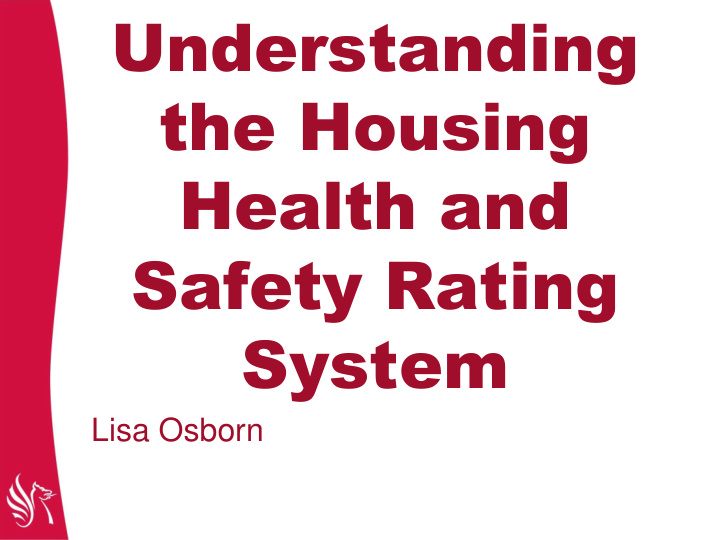



Understanding the Housing Health and Safety Rating System Lisa Osborn
The Private Rented Sector
The PRS in North Somerset • Highest levels of PRS are in WSM Central Ward (46%), West (35%) East (24%) • 20.2% properties with Category 1 hazards (PRS) • Pre 1919 stock most likely to contain hazards
What is HHSRS? • Allows the assessment of main potential housing related hazards • Emphasis directly on the risk to health and safety of occupant • Development took many years a concept in 1998 introduced in 2006 – replaced the old ‘fitness standard’
Underlying Principle Any residential premises should provide a safe and healthy environment for any potential occupier or visitor
Legal Status • Housing 2004 Part 1 Housing Conditions http://www.legislation.gov.uk/ukpga /2004/34/contents • Operating Guidance https://www.gov.uk/government/upl oads/system/uploads/attachment_d ata/file/15810/142631.pdf
HHSRS • HHSRS is concerned with someone suffering harm over the next 12 months and improving the deficiency • Backed up by national statistical evidence from health records
So what is HHSRS? • Used by council to assess risks to health and safety • Links between health and housing • Risk assessment approach not a set of standards • Likelihood of an occurrence (in next 12 months) • Harm Outcome • 29 different hazards
29 different hazards • Physiological Requirements • Damp and mould, excess cold, • Psychological Requirements • Crowding and space, entry by intruders • Protection against infection • Sanitation, food safety • Protection against accidents • Falls, electric’s, fire
Process of HHSRS • Inspection and review deficiencies, compare to ideal, compare to average property of similar age • Score the hazard - likelihood and harm outcome (taking account national averages) • Hazard score and band generated • Category 1 hazards mandatory works
Damp and Mould?
Yes!
NO!
Lighting?
NO!
Falls on Stairs?
Yes!
Most common hazards reported to council in 2016 • Damp and mould 45% (122) • Cold 19% (53) • Personal/Domestic hygiene 16% (43) • Electrical 8% (23) • Fire 6% (17) • Falls 5% (15)
But that doesn’t add up to 100% Remaining 12% cover a further 9 hazards: Security, structural collapse, asbestos, overcrowding, food safety, water supply, carbon monoxide, explosions and lighting. Total complaints in 2016 = 281
Further guidance • Guide for landlords/agents https://www.gov.uk/government/upl oads/system/uploads/attachment_d ata/file/9425/150940.pdf • WoE Checklist http://www.westofenglandrentalstan dard.co.uk/siteassets/files/text/66b7 e3ad16a1f16a4ee480f9fb024748.p df
Any Questions?
Recommend
More recommend